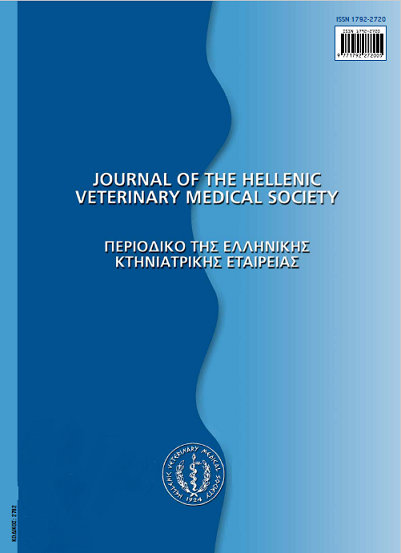Μυκοβακτηριακές λοιμώξεις των πτηνών

Περίληψη
Η σημασία των μυκοβακτηριακών λοιμώξεων των πτηνών συστηματικής εκμετάλλευσης μπορεί σήμερα να είναι μειωμένη λόγω της ευρείας εφαρμογής συγχρόνων μεθόδων εκτροφής, η μελέτη τους όμως συνεχίζει να είναι επίκαιρη αναφορικά με την προστασία της υγείας των πτηνών, των ζώων και του ανθρώπου. Στις μυκοβακτηριακές λοιμώξεις των πτηνών εμπλέκονται κυρίως μέλη του Mycobacterium avium complex (MAC), τοοποίο διακρίνεται σε 28 ορότυπους που ανά ομάδες συνιστούν είδη:οι ορότυποι 1 έως 6, 8 έως 11 και ο ορότυπος 21 αποτελούν το είδος Μ. avium subsp. avium (ΜΑ), οι ορότυποι 4 και 8 αναφέρονταικαι ως Μ. avium subsp. hominisuis, ενώ οι ορότυποι 7,12 έως 20 και 22 έως 28 συνιστούν το Mycobacterium intracellulare. Από τα μυκοβακτήρια που συνιστούν το MAC, εκείνα που προκαλούν γενικευμένη φυματίωση στις όρνιθες είναι μόνοοι ορότυποι 1 έως 3 του ΜΑ. Λοίμωξη από τους υπόλοιπους ορότυπους του ΜΑ και από το Μ. intracellulare προκαλεί, συνήθως, μόνο εστιακές φυματιώδεις αλλοιώσεις. Στα παραπάνω έχει προστεθεί τελευταία και ένα ακόμη είδος, το Mycobacterium genavense, που αναγνωρίζεται ως παθογόνο για τα πτηνά. Περιστατικά μυκοβακτηριακών λοιμώξεων στα πτηνά έχουν καταγραφεί παγκοσμίως. Η εισαγωγή του νοσήματος σε μια εκτροφή γίνεται κυρίως με την αγορά μολυσμένων πτηνών που αποβάλλουν τα μυκοβακτήρια με τα κόπρανα τους. Η είσοδος του μικροβίου στον οργανισμό γίνεται στις περισσότερες περιπτώσεις μέσω της στοματικής, και σπανιότερα, μέσω της άνω αναπνευστικής οδού. Η φυματίωση των πτηνών σε μία εκτροφή εκδηλώνεται συνήθως με σποραδικά κρούσματα αιφνίδιων θανάτων, απώλεια βάρους και μείωση της ωοπαραγωγής. Τα κλινικά συμπτώματα μπορεί επίσης να προέρχονται από την προσβολή του εντέρου, των οστών, των πνευμόνων ή του δέρματος. Τα νεκροτομικά ευρήματα είναι παθογνωμονικά μόνο εφόσον ανευρεθουν φυμάτια στα παρεγχυματικά όργανα και κυρίως στο μυελό των οστών. Για την εργαστηριακή διάγνωση των μυκοβακτηριακών λοιμώξεων των πτηνών χρησιμοποιούνται ορολογικές εξετάσεις, η μικροσκοπική εξέταση επιχρισμάτων κοπράνων και η απομόνωση του μυκοβακτηρίου με καλλιέργεια από παθολογικά υλικά, που αποτελεί και σήμερα τη μέθοδο αναφοράς. Τα τελευταία χρόνια εφαρμόζονται και κάποιες μέθοδοι που βασίζονται σε τεχνικές της Μοριακής Βιολογίας, από τις οποίες πιο ευρέως διαδεδομένη είναι η αλυσιδωτή αντίδραση της πολυμεράσης (ΑΑΠ). Η καλλιέργεια παθολογικών υλικών γιατην απομόνωση μυκοβακχηρίων ξεκινά με την απομόλυνση (decontamination) του δείγματος από άλλα συνυπάρχοντα βακτήρια, των οποίων η ανάπτυξη δεν θα επέτρεπε την ανάδειξη της παρουσίας των μυκοβακχηρίων. Στη συνέχεια ακολουθεί ενοφθαλμισμός σε ειδικά θρεπτικά υποστρώματα που για το MAC είναι συνήθως το Lowenstein-Jensen και το Middlebrook 7Η11. Η επώαση γίνεται σε ατμόσφαιρα 5-10% διοξειδίου του άνθρακα για τουλάχιστον 4-6 εβδομάδες. Η ταυτοποίηση των αποικιών που αναπτύσσονται γίνεται με ειδικές βιοχημικές δοκιμές ή με την ΑΑΠ που μειώνει κατά πολύ το χρόνο που απαιτείται για την τελική γνωμάτευση. Οι γενωμικές περιοχές, που χρησιμοποιούνται συνήθως γιατην ανίχνευση και ταυτοποίηση του MAC με ΑΑΠ, είναι οι ακόλουθες: 16SrRNA, hsp65, IS1245 και η IS901. Ειδικά για το Μgenavense, που είναι από γενετικής απόψεως πολύ συγγενές με το ΜΑ, εφαρμόζεται ΑΑΠ για την ενίσχυση μίας επιλεγμένης περιοχής του γονιδίου της πρωτείνης θερμικού shock 65kDa και στη συνέχεια η πέψη του προϊόντος ενίσχυσης με το ένζυμο περιορισμού SaR.
Λεπτομέρειες άρθρου
- Πώς να δημιουργήσετε Αναφορές
-
FRANGIADAKI (Ε. Γ. ΦΡΑΓΚΙΑΔΑΚΗ) E., IKONOMOPOULOS (Ι. Α. ΟΙΚΟΝΟΜΟΠΟΥΛΟΣ) J., BALASKAS (Χ. ΜΠΑΛΑΣΚΑΣ) C., & GAZOULI (Μ. ΓΑΖΟΥΛΗ) M. (2017). Μυκοβακτηριακές λοιμώξεις των πτηνών. Περιοδικό της Ελληνικής Κτηνιατρικής Εταιρείας, 57(2), 127–139. https://doi.org/10.12681/jhvms.15017
- Τεύχος
- Τόμ. 57 Αρ. 2 (2006)
- Ενότητα
- Review Articles
Οι συγγραφείς των άρθρων που δημοσιεύονται στο περιοδικό διατηρούν τα δικαιώματα πνευματικής ιδιοκτησίας επί των άρθρων τους, δίνοντας στο περιοδικό το δικαίωμα της πρώτης δημοσίευσης.
Άρθρα που δημοσιεύονται στο περιοδικό διατίθενται με άδεια Creative Commons 4.0 Non Commercial και σύμφωνα με την άδεια μπορούν να χρησιμοποιούνται ελεύθερα, με αναφορά στο/στη συγγραφέα και στην πρώτη δημοσίευση για μη κερδοσκοπικούς σκοπούς.
Οι συγγραφείς μπορούν να καταθέσουν το άρθρο σε ιδρυματικό ή άλλο αποθετήριο ή/και να το δημοσιεύσουν σε άλλη έκδοση, με υποχρεωτική την αναφορά πρώτης δημοσίευσης στο J Hellenic Vet Med Soc
Οι συγγραφείς ενθαρρύνονται να καταθέσουν σε αποθετήριο ή να δημοσιεύσουν την εργασία τους στο διαδίκτυο πριν ή κατά τη διαδικασία υποβολής και αξιολόγησής της.


